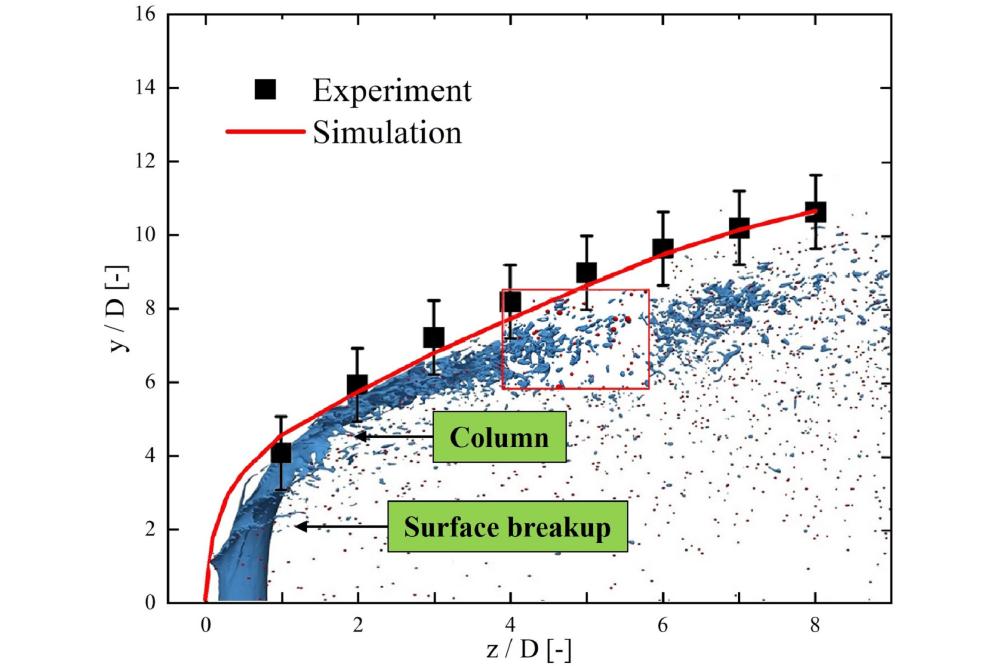Automatic Coupling Method of Volume-of-Fluid and Lagrangian Particle Tracking for Spray Atomization Simulation in OpenFOAM
Introduction
Despite recent advances in numerical methods for multiphase flows, the complete simulation of a spray atomization is still challenging due to the wide range of length and time scales involved. The spray evolvement process can be divided into three regimes. In the first, the so-called primary breakup, the liquid jet or sheet exhibits large scale coherent structures that interact with the gas-phase and break up into both large and small scale drops. The second is the transition zone in which secondary breakup takes place. Thereby, the initially formed drops break up into ever smaller drops (droplets) that finally may evaporate. This regime builds together with the primary breakup the atomization process within the so-called dense spray region. The last regime within the so-called dilute region features the flow of almost spherical dispersed droplets. While the primary atomization can be solved by the Volume-of-Fluid (VOF) method, Lagrangian particle tracking (LPT) method is suitable for the dilute spray region. The objective of the project is to propose and validate an automatic coupling without any localized regime interface between both methods using OpenFOAM to describe the complete spray propagation process including the spray atomization.
Methods
Large eddy simulation (LES) will be carried out using the open-source C++ library OpenFOAM version 2006. Thereby, the flow solver interFoam is employed that solves the primary atomization by means of the volume of fluid (VOF) phase-fraction based interface capturing approach. The LPT method is applied to track the droplets resulting from the secondary breakup. The droplets are treated as point masses and thus contain no volume.
Results
Figure 1(a) shows the penetration jet trajectory in JICF of the simulation result compared with the experimental data. It can be seen that the penetration jet trajectory from the simulation agrees well with the experiment. Additionally, the iso-contour of α = 0.5 is added to the plots to help visualizing the spray evolution. The surface breakup, i.e., liquid droplets shedding from the liquid column, can be observed in the simulation. In the column region, the liquid jet penetrates into the crossflow, bends in the airflow direction and then the jet is accompanied by droplets continuously peeling off along the edges of the liquid column. Figure 1(b) which is the zoomed-in view of Figure 1(a) displays the spray evolution in the LJIC. The liquid mass simulated by VOF method is coloured blue and the particles tracked by LPT are colored red. As stated earlier, all the VOF droplets that meet the conversion criteria from the phase field are converted into the Lagrangian framework. It can be observed that the breakup of liquid column and ligaments are resolved properly by the VOF method. Droplets that meet the conversion criteria from the column breakup and fragments of the ligaments are converted to Lagrangian particles and then safely tracked by the LPT approach. The spray cone angle in the pressure-swirl atomizer is compared with experimental data is used for extracting the spray angle. The initial spray cone angle is developed in a region before the breakup of the liquid sheet. Figure 2 presents a comparison of the predicted spray cone angle with the experimental result. The cone angle θ from experiment amounts ca. 92 degrees, while the predicted spray angle with ca. 90 degrees shows a quantitative error of around 3% under prediction. Having in mind this acceptable predictive accuracy, further comparison studies and analysis can be carried out.
Discussion
A automatic coupling of VOF and LPT approaches was applied to numerically investigate the complete spray atomization of a liquid jet in a cross flow (LJIC) and a pressureswirl atomizer. Comparisons of the VOF-LPT simulation with the experimental measurement data demonstrate the good capability of this method to simulate the complete atomization process of the liquid sprays and to reproduce in a satisfactory way the main features reported in the experiments.






